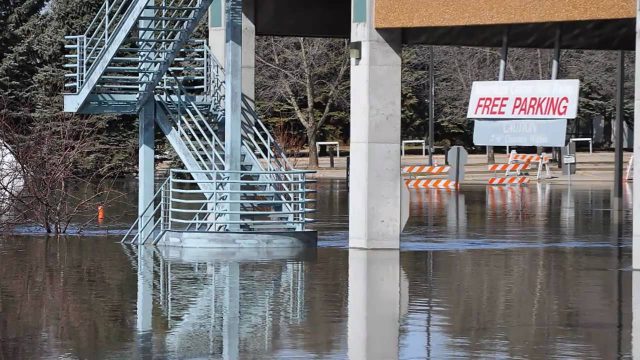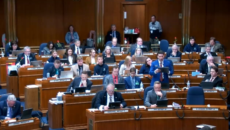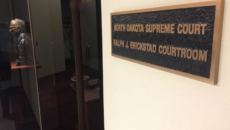Guest Post: Fargo-Moorhead Diversion Project Is A Disaster

Having experienced many of the various cultures here in the United States, there is one aspect of North Dakota and the mid-West that I am incredibly fond of – one that sets itself apart from many other parts of the country – the sense of community. The unconditional friendliness towards one’s neighbor is something that many other communities fall short of, which is why I was dumbfounded when I learned about the Fargo-funded plans for the FM diversion and a shortage of outrage towards it.
In essence, the Diversion Authority and the Army Corps of Engineers plan to build two dam embankments that will tie into equally high ground south and east of the diversion inlet. This area, roughly 50 square miles, is known as the staging area, which will be deliberately flooded.
The dams, coupled with landscape orientation, will force the floodwater into the inlet and through the diversion. The diversion itself will be about ten miles long, 300 feet wide at the base, 2,000 feet wide between the peaks, and will reconnect with the Red River near Georgetown. A flow-control structure comprised of three gates will be built into the east-west dam at the intersection of the Red River, in addition to other structures at river intersections.
Already there are a number of problems. First and foremost, this plan robs our neighbors of their homes, their churches, their farms, their businesses, and more. Farmers who wish to brave the floods and continue farming their land will lose their flood insurance as well as substantial property value. They will also lose months of farming time and money whilst having to wait for drainage as well as the cleanup of dead and rotting fish. A single year passed without cultivated crops could drive a farmer out of business and leave an entire family with crippling debt.
A lesser-known consequence is that the community’s only wildlife refuge, found on the Minnesota side of the staging area, would be lost. This is in addition to countless business, including the iconic Knickerbocker.
Next, the devastating effects that will occur at Georgetown and beyond have been ignored. The Diversion Authority and Corps of Engineers declined to discuss these effects at the most recent public forum, stating that they have yet to assess the potential damage this plan will create. Some speculate that the repercussions along the river will be suffered all the way to Canada.
Our neighbors to the west of the diversion have also been left in the dark. Many feel that this will have devastating effects on the ability to drain water properly and could potentially lead to further flooding. Anything between Davenport to Mapleton to Argusville and beyond could suffer such consequences.
Another fear I bear is of the governing body that is put in control of the dam’s gates at the Red River intersection. It could choose restrict water flow into the Red River, thus causing exponentially more devastating flooding in rural Cass.
This plan already projects that a 50-year flood event (like the 2007 flood) is suspected to push floodwaters outside of the staging area. A 100-year event (something slightly worse than the 2009 flood) pushes water into Richland County past Christine. Keeping the gates low could easily turn the effects of a 10-year flood into a 50-year flood, or a 100-year flood into a 500-year flood in and beyond the staging area.
As though we needed a feather to break the camel’s back at this point, the project, when operating according to plan, caps the Red River height at 35 feet at the dam, so volunteer work and sandbagging will still be required in city limits. And I haven’t even discussed the financial ramifications at this point.
Although the original plans for a Cass/Clay 2-diversion system have been altered to a single diversion system mostly built in Cass, the central planners are still requesting that one-fourth of the $2billion bill be paid for by Minnesota, who has kindly said no. The state is expected to pay half of the total, with the remainder coming from the federal government. The state has already also said no, pending a decision by the federal government, which is likely two years away. Without proper funding – or a plan resembling anything close to legal – I’m sure they will also say no. The next two years will be a waste of taxpayer’s dollars, funding planners that are developing a “solution” in service to a city instead of the county, as they should be.
This also brings to light the immorality of asking Minnesota to pay for a project that brings no benefit to them, but instead deliberately floods their communities in southern Clay in addition to those who live in close proximity to the river, north of Georgetown and beyond.
Furthermore, any delay or legal process is an inherent and unaccountable cost for this project – it can’t be budgeted for. For example, if they should discover a Native American burial ground in their path, construction will screech to a halt, as federal law protects them. In addition to legal action from native tribes should this unfortunate event occur, I have no doubt this plan will be met with litigation from a variety of dissenters.
Families and business owners who refuse to sell their property or be intentionally flooded will rightfully dispute this. Any attempts at eminent domain will be justly challenged. Other counties will file suit when they are adversely affected by the plans – prosecution by Clay, Traill, and Richland counties is a virtual guarantee. West Fargo may also get involved, as the diversion land-locks future development strategies and lowers property value in the area.
Taxpayers will be footing the bill so defense attorneys can be bought and paid for in order to defend this atrocity. This will delay the project for a decade, optimistically. When the prosecutors win, the plans will either have to be scrapped entirely, wasting over a decade’s worth of funding and planning, or they will need to include plans to protect every dissenting individual who just won the lawsuit, which will increase costs exponentially.
Moreover, the Commission will need to pay for any consequences – unforeseen or otherwise – of the diversion within its jurisdiction. This includes any demands for bridges across the diversion, drainage projects, cleanup, and road construction. Roads in the staging area will be unsafe, as the weight of the standing water coupled with the weakened ground underneath will no doubt destroy them. Naturally, property would immediately devalue once the land is acquired for construction, causing the County Commission to forfeit all revenue it previously generated from property tax. These situations will cause increases in taxes to compensate for the losses.
And, of course, heaven forbid, should the dams fail, especially the east-west dam, water would consume the county at an alarming rate. In the worst case scenario water would rush towards the metropolitan area at a terrifying rate – inches per hour or faster, as opposed to the inches per week we currently and feasibly contend with during our sandbagging operations.
This plan is a moral, intellectual, and fiscal disaster. Moreover, I dare say it is an indictment of the current corrupt state of government. While the project’s focus should be diverting flood-waters in a reasonable time and at a reasonable cost, it instead irresponsibly and dishonorably diverts Fargo’s flood problems directly onto all of rural Cass County and beyond, while placing the burden of tremendous and incalculable debt squarely on the shoulders of every Cass County resident. This is a plan that solely protects the city and its development – a violation of federal law in and of itself. Thereby it is justifiably being called the Fargo-Moorhead Diversion. This current plan does not serve Cass County at all, only the metropolitan area. This is qin spite of the fact that this responsibility belongs to the Cass County Commission. Many people have stepped forward and proposed sensible solutions to the flood issues – solutions that protect all of Cass County equitably and responsibly. I advocate strongly for the research of those solutions and the opposition of the current project.







